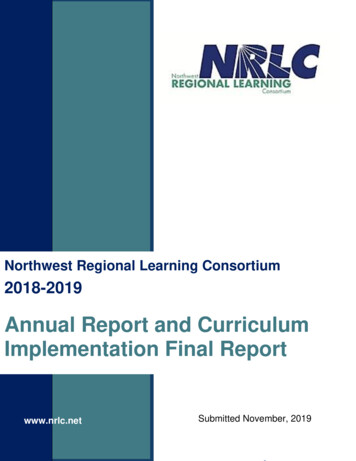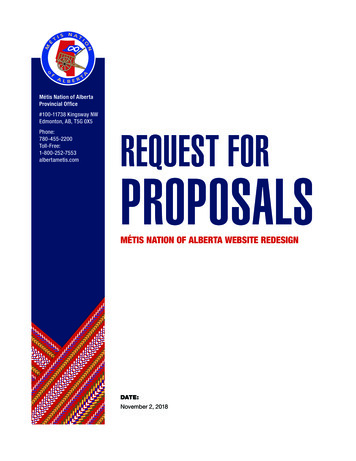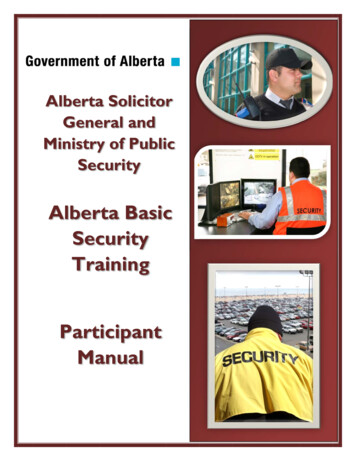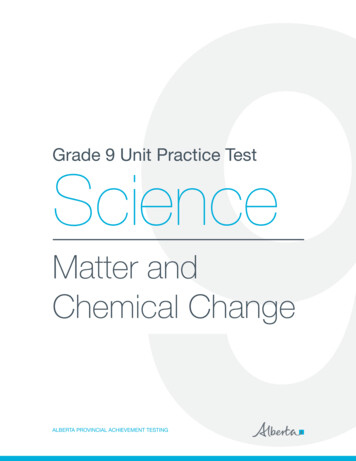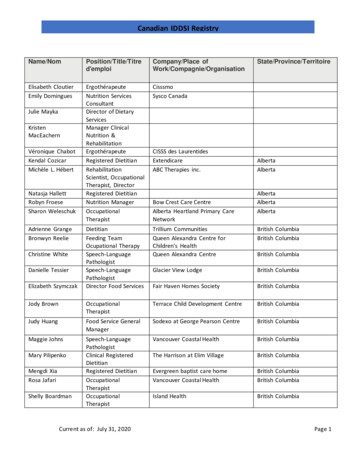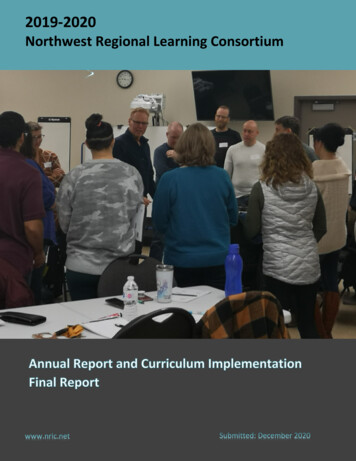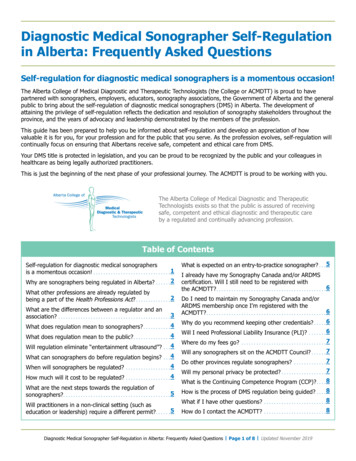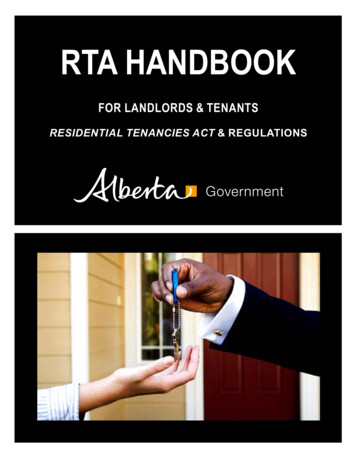
Transcription
RTA HANDBOOKFor Landlords & TenantsResidential Tenancies Act & Regulations
2
CONTENTSINTRODUCTION. 5DEFINITIONS. 7RESPONSIBILITIES OF LANDLORDS AND TENANTS. 19Residential tenancy agreements. 23INSPECTION REPORTS . 29SECURITY DEPOSIT . 33Residential tenancy AGREEMENTS FEES & CHARGES. 41LANDLORD’S DISTRAINT (Distress) . 45RENT INCREASES . 47LANDLORD’S RIGHT OF ENTRY. 53SECURITY - KEYS & LOCKS . 59TERMINATION OF A TENANCY. 61NORMAL WEAR & TEAR. 77ABANDONED GOODS. 81EMERGING TRENDS. 85EMERGING ISSUES. 86RESOURCES AND REFERRAL INFORMATION. 883
4
INTRODUCTIONPURPOSE:This Handbook is designed to explain the rights and responsibilities of all tenants, landlords, and agentsinvolved in renting residential premises in Alberta under the Residential Tenancies Act (RTA) and regulations: Residential Tenancies Exemption Regulation Residential Tenancies Ministerial Regulation Residential Tenancy Dispute Resolution Service Regulation Security Deposit Interest Rate Regulation Subsidized Public Housing RegulationThe Handbook will explain the minimum legislated requirements set out in the RTA. It provides landlords andtenants with options to deal with matters not established as minimum requirements and makes residentialtenancy resource material available in a user-friendly format.HOW TO USE THIS HANDBOOK:Words and terms that are commonly used in relation to tenancies and the RTA are defined in the Definitionsection at the beginning of this handbook. The sections include Statutory References, Guidelines, PracticalApplications, and Forms information.CASE LAWYou can search for cases tried in Alberta Court of Queen’s Bench pertaining to “residential tenancy” http://www.canlii.org/en/ab/abqb/Environmental Public Health Legal Penalties & OrdersThe Environmental Public Health Program may prosecute owners and operators of public places thatcontinue to use unsafe practices that may endanger people. Orders and court cases are available at this 50.aspxDISCLAIMER:As a Handbook on residential tenancy matters, this does not set out everything in the RTA, nor does it statethe law. Landlords and tenants should refer to the RTA to determine their legislative rights and obligations. Inevery instance, the law as set out in the RTA governs.5
6
DEFINITIONSThere are a number of words that are commonly used in the RTA, regulations, andin the rental business. Understanding what these words mean, and how they areused, is an important part of understanding what residential tenancies are all about.These are plain language definitions for the commonly used terms in this guide.AAbandonAbandoned GoodsAbatement Of RentAn action of a tenant who leaves the residential premises before the end of thetenancy, without giving notice to the landlord that they are leaving.Any property a tenant leaves behind after they move out of the residentialpremises.A reduction in the amount of rent a tenant is required to pay to the landlord. Anabatement of rent can occur on a one-time-only basis; for a specified period oftime; or be on-going.A person who has been given the authority by another person to undertakecertain activities on their behalf.Examples include:Agent A leasing agent who is given the authority to enter into a residential tenancyagreement with a tenant on behalf of the landlord. A building caretaker who is given the authority to enter the residentialpremises to make repairs on behalf of the landlord.AgreementSee Contract definitionA person assigns their right or obligation to another person, or the writtendocument that transfers a right or obligation.Assign Or Assignment7 An example is the tenant in a fixed term tenancy wants to move out of theresidential premises before the end of the residential tenancy agreement.The tenant finds someone else who will move in and take over the tenant’srights and obligations. The tenant wants to assign the residential tenancyagreement to this other person.
BBailiffBreachSee Civil Enforcement Bailiff definition.Refers to breaking, or not keeping, one or more of the promises a tenant andlandlord made to each other in the residential tenancy agreement. A breach can happen when either the tenant or the landlord doesn’t do whatthey promised to do, or when they do something they promised not to do.CA person who is authorized by agreement under the Civil Enforcement Act tooperate as a civil enforcement agency.Civil EnforcementAgencyCivil EnforcementBailiffCommon AreasConsent8 Civil enforcement agencies are privately owned and operated bailiffcompanies. They are authorized by the Sheriff on behalf of the Ministerof Justice to carry out seizures on personal property, sell seized property,distribute proceeds from the sale of seized property, carry out evictions andcarry out court orders. Look for them in the yellow pages under Civil Enforcement Agencies.A person who has been appointed by the Sheriff under the Civil EnforcementAct. A civil enforcement bailiff has the authority to seize property that belongs tosomeone who owes money. Civil enforcement bailiffs are employed by or undercontract to a civil enforcement agency and have the authority to seize personalproperty, remove seized property, carry out court orders and evictions.Those parts of the residential premises that can be used by all tenants and areunder the control of the landlord. Common areas may include hallways, stairs, tenant storage rooms, parkingareas, sidewalks, landscaping and laundry rooms.Means to give permission. An example of consent is that the landlord has to give permission to thetenant before the tenant can change the locks to the residential premises. Another example of consent would be the tenant giving permission to thelandlord to enter the residential premises without notice to do an inspectionor make repairs.
The promises made by two or more people to each other, that each will dosomething that will benefit the other. In a contract, there must be agreement by all the persons on what they arepromising each other. Can be in writing or spoken words. The residential tenancy agreement is a contract.Contract In law, a contract is enforceable through the court.Refers to having the legal right to make a decision.ControlCourtCovenant An example of control is that the tenant can make the decision where to puttheir belongings inside the residential premises. Another example is that the landlord can make the decision what colour topaint the outside of the building.The Provincial Court of Alberta or the Court of Queen’s Bench of AlbertaThe RTA says there are certain things the landlord and the tenant must do ornot do. It can also be a promise between a landlord and a tenant.DDamageRefers to harm to property or a person. The court or Residential TenancyDispute Resolution Service (RTDRS) decides if there has been damage andwho caused it.Damage DepositSee “security deposit” definitionDamagesDistraint, Distrain OrDistressE9Refers to the amount of money that is needed to repair any damage thathas been done. When the court or RTDRS decides there has been damage,and who caused it, and who is responsible to fix it, the court or RTDRS alsodetermines the financial remedy.The common law remedy of the landlord to seize the tenant’s property through acivil enforcement agency when the tenant hasn’t paid the rent. The landlord cannot use the remedy of distraint if the landlord hasterminated the tenancy.
EvictThe procedure used to remove the tenant and their possessions from theresidential premises when the tenant doesn’t leave at the termination of tenancy.Any type of proof presented by the landlord or tenant including: Written documents (tenancy agreement, receipts, letters, pictures, witnessstatements). Photographs, video or audio recordings and other physical evidence. Oral statements of the parties or witnessesEvidenceExclusive PossessionHaving possession, control and use of the residential premises.FA tenancy that begins on a specific day, and ends on a specific day.Fixed Term Tenancy Neither the landlord nor the tenant has to give notice to the other partyto end the fixed term tenancy agreement. If the landlord agrees to allow the tenant to continue renting, the RTA saysthe tenancy automatically becomes a periodic tenancy, unless the landlordand tenant make a new residential tenancy agreement.HThe residential premises must be fit for someone to live in.Habitable The Public Health Act, Minimum Housing & Health Standards and otherRegulations, Bylaws and Codes, all set out requirements for the conditionof premises where people live. If these requirements are not met, then theHoliday10premises may be deemed not habitableIn accordance with the Interpretation Act, if a due date, under the RTA, falls on aholiday or Sunday, the next business day becomes the due date, e.g., January 2and July 2.
IA written report that the landlord and the tenant do together at the beginning andend of the tenancy. The report records the condition of the residential premisesbefore the tenant moves in, and after they move out. The inspection report doneat the beginning is often called the move-in inspection report, and the one atthe end is often called the move-out inspection report. The residential premisesmust be fit for someone to live in.Inspection ReportThe RTA says the inspection report has to be in writing; that both the landlordand tenant should be present when it is done; and that both should sign it after itis done. The RTA says the inspection report must include certain statements thatmust be signed within the report. A landlord can do the inspection without the tenant being present if thelandlord has offered the tenant two inspection times and the tenant does notagree to attend. A copy of the move-in and move-out inspection reports must be given to thetenant as soon as they are completed.LThe legal owner of the residential premises, or some other person that hascontrol of the residential premises. A property manager, leasing agent, caretaker, building manager, or any otherperson who controls whether someone can rent the place is a landlord. A person who, in law, has the same rights as the landlord is a landlord.Examples include the heirs of the landlord; secured creditors acting on theirsecurity; or someone who obtains ownership from the landlord. Any person who has a right of possession of the residential premises andthe right to go to court to ask for enforcement of the landlord’s rights is also alandlord. An example of this is a tenant who has entered into an agreementwith the landlord to assume the role of landlord in renting out units withinspecified residential premises.Landlord11
MMaintenanceMonth-To-MonthTenancyRefers to looking after the residential premises. It includes keeping the premisesreasonably clean. Generally speaking, unless the residential tenancy agreementsays something different, the landlord is responsible for maintenance of thecommon areas and the tenant is responsible for maintenance of the inside of theresidential premises.A periodic tenancy that automatically renews each month.NNormal Wear And TearThe gradual worsening of the condition of property over time that happens evenwhen the property is looked after properly. For example, even if walls are regularly washed and cared for, eventuallyover a number of years, they will have to be repainted. This is normal wearand tear. If the walls are not looked after, or holes are knocked in them, thisis damage and not normal wear and tear. Another example is that carpets wear out over time and have to be replaced,even though they have been properly and regularly cleaned. This is normalwear and tear. Cigarette burns, oil stains, or pet stains in the carpet that require expensivecleaning or replacement of the carpet before it is worn out is damage andNoticeNotice Of Entrynot normal wear and tear.A written document from the landlord to the tenant, or from the tenant to thelandlord, about something in the residential tenancy agreement. A notice shouldalways be written, show the date of the notice, and be signed by the persongiving the notice.A written notice that a landlord serves on a tenant when the landlord wants toenter the residential premises. Once a landlord has served the proper notice ofentry, the tenant has to allow the landlord entry to the residential premises at thetime specified in the notice of entry for the reason stated. The RTA says that a landlord does not have to give a notice of entry if thelandlord has reasonable grounds to believe that there is an emergency inthe residential premises, or that the tenant has abandoned the residentialpremises.A form that the civil enforcement bailiff gives to the tenant. The tenant can fill outthe form and file it with the seizing civil enforcement agency within 15 days toobject to the seizure. Notice Of Objection ToSeizure12The tenant can, of course, consent to the landlord entering the residentialpremises at any time.
Notice Of TerminationA form that a landlord or a tenant serves on the other party to end the tenancy.Notice To VacateA form that the landlord serves:On people who are not tenants and who are living in the residential premises with the tenant, and who are not authorized by the landlord to live in theresidential premises (14-day notice).On people who are not tenants and who are living in the residential premises after the tenant has abandoned the residential premises (48-hour notice).OA document that a court or RTDRS gives to a landlord to direct a person to moveout of the residential premises.A tenant who does not move out when the tenancy has ended, and no longerhas a right to be there.Order for Possession An example is the tenant who stays after the fixed term tenancy has come toan end, and there is no periodic tenancy that allows the tenant to stay in theresidential premises. Another example is a tenant who does not obey a court or RTDRS order thatsays the tenancy is terminated.Overholding TenantPThe right of the tenant not to be disturbed while living in the residential premisesso long as they meet their obligations under the residential tenancy agreement.Peaceful EnjoymentPeriodic TenancyPrescribed13This includes disturbance or conflict with the landlord or with other tenants inthe same building. It is the landlord’s responsibility to take action if something iscausing problems for the tenants like: Excessive noise (other than activity in the normal course of everyday living). Aggressive or obnoxious behavior. A disturbance caused by the landlord, tenant or someone permitted on thepremises by the landlord or tenant.A tenancy that ends automatically at the end of each week, month or year andthen begins again automatically at the beginning of the next week, month oryear.Detail that is stated in the Regulations. There are several instances in theResidential Tenancies Act that speak to something being prescribed. TheRegulations are another form of law that is in addition to the law contained in theResidential Tenancies Act.
RMeans, in law, when someone is able to go to court or RTDRS and ask the courtor RTDRS to address a problem they are having. An example is that the landlord is able to go to court and ask the court togive them an order of possession when the tenant has not paid the rent andRemedywill not move out. RentAnother example is when the tenant repairs something in the residentialpremises that the landlord ought to have fixed. The tenant can go to courtand ask for an abatement of rent or payment for performing the landlord’sobligations.Rent is normally an amount of money that the tenant agrees to pay to thelandlord on a certain day for each tenancy period (weekly, monthly or yearly)that the tenant is living in the residential premises. Rent can be anything of value that the tenant gives to the landlord, and thelandlord takes, to allow the tenant to live in the residential premises.Fixing something that’s either broken or not working properly. It also meanslooking after the residential premises and the things in it so that they don’t needfixing (keeping the place in good repair). The residential tenancy agreement should say what the landlord isresponsible for looking after and repairing, and what the tenant isresponsible for looking after and repairing. If the agreement does not speak to this issue, the landlord is usuallyresponsible for the building structure (including windows, doors, walls, roof,ceilings, and floors), the plumbing, wiring, and heating and air conditioning(if there is any) and appliances provided by the landlord. This would alsoinclude the common areas unless the parties agree otherwise, whichincludes the hallways, utility and storage rooms, parking areas, sidewalksand landscaping (including lawn care and snow removal). The tenant is responsible to keep the inside of the residential premises cleanRepairRepudiation, Repudiate14and not cause any damage. Things like replacing burned out light bulbs andsmoke detector batteries are the tenant’s responsibility.To refuse to perform the right, duty, privilege or obligation owed to the otherparty under the contract, or residential tenancy agreement.
Residential PremisesResidential TenancyAgreementThe place the tenant rents from the landlord to live in. For the purpose of thishandbook, residential premises includes the yard of a single family, semidetached or condominium dwelling, etc., and detached buildings such as agarage or a storage building, that is for the exclusive use of the tenant.The contract, sometimes called a lease, between the tenant and the landlord torent residential premises. This agreement can be in writing; it can be in spoken words; or it can evenbe implied from the situation. A verbal agreement is a contract between the landlord and the tenant that isnot in writing.An implied agreement is a contract that is not agreed to verbally or in writingby the landlord and tenant. They act towards each other in a way that is thesame as if they did have an actual agreement.The RTDRS provides landlords and tenants with an alternative to the courtsfor resolving disputes. After a landlord or tenant files an application, a TenancyDispute Officer hears the case and is authorized to make binding decisions onclaims of up to 50,000. Residential TenancyDispute ResolutionService (RTDRS)SMoney or other items given by the tenant to the landlord at the beginning of thetenancy. The security deposit, sometimes called damage deposit, is held bythe landlord and applied against any damage caused by the tenant during thetenancy or other obligations of the tenant to the landlord. The security depositcan also be applied against the amount of rent owed and not paid at the end ofthe tenancy. The security deposit cannot exceed the value of one month’s rent. Thelandlord must hold security deposits in a separate bank account in trust forSecurity Depositthe tenant. The landlord must pay interest (as prescribed) on the securitydeposit either every year, or at the end of the tenancy. The RTA says that, at the end of the tenancy, the landlord cannot useany of the security deposit to pay for damage caused by a tenant, unlessa move-in inspection report and a move-out inspection report has beencompleted.(see Security Deposit section)Seize15To take possession of personal property through a legal process.
To deliver a document, usually a notice, to someone.The RTA requires notices, orders and documents to be served personally, byregistered or certified mail, orIf the landlord is unable to serve the notice on the tenant because the tenant isnot at the residential premises or is evading service, the notice can be served:Serve On any adult who apparently resides with the tenant, or By posting it in a conspicuous place on some part of the residentialpremises, or If a landlord or tenant cannot contact the other party in person, by registeredor certified mail or by posting a notice on the premises, as a last resort thenotice may be sent through electronic means. The electronic method mustresult in a printed copy of the notice. Sliding a notice under the door of residential premises does not meet theRTA requirements for serving notices. Security deposit refund cheques and statements of account can be servedpersonally, by registered or certified mail and also by regular mail delivery.The courts and RTDRS may have different requirements for service ofdocuments they use or issue.A written document that the landlord gives to the tenant that itemizes interestearnings and deductions related to the tenant’s security deposit. The landlordStatement Of Accountmust provide the statement of account showing the actual costs, or an estimateof the expected costs, within 10 days of the end of the tenancy.If an estimated statement of account is initially provided within the 10 days, theSubstantial Breachfinal statement of account and any remaining balance must be provided to thetenant within 30 days of the end of the tenancy.A breach of a covenant specified in the RTA. It can also be a series of breachesof the residential tenancy agreement that, added together, amount to asubstantial breach or one serious breach of a covenant in the residential tenancyagreement. (see Termination of a Tenancy section)TTenancyTenancy Month16The legal right to live in residential premises that someone else owns. A featureof a tenancy is that the tenant has, in law, the exclusive use of the residentialpremises. If the tenant lives up to their end of the residential tenancy agreement,the landlord has no right to interfere with the peaceful enjoyment of theresidential premises.A period on which a periodic tenancy can be based. A tenancy month does notnecessarily have to be a calendar month. As an example, the tenancy monthmay run from the 1st day of the month to the end of the month, but it may alsorun from the 15th day of one month to the 14th day of the next month.
Tenancy WeekTenancy YearTenantA period on which a periodic tenancy can be based. A tenancy week does notnecessarily have to be a calendar week. As an example, the tenancy week mayrun from Monday to the next Sunday, but it may also run from Wednesday to thenext Tuesday.A period on which a periodic tenancy can be based. A tenancy year does notnecessarily have to be a calendar year. As an example, the tenancy year mayrun from January 1st to December 31st, but it may also run from July 1st to June30th.A person, or persons, who have permission to live in someone else’s premisesbecause they have a residential tenancy agreement. A tenant is also a personor persons who have permission to live in a place because of a sublet orassignment of a residential tenancy agreement. Included in the definition oftenant are the heirs of the tenant. The RTA sets out certain instances when a tenant who is no longer living inthe residential premises is still considered the tenant for such purposes as:the move-out inspection report, abandoned goods, recovery of damages andreturn of a security deposit.The end of the tenancy and the residential tenancy agreement.Termination In a fixed term tenancy, the termination date is specified in the tenancyagreement. Trust AccountIn a periodic tenancy, termination happens when either the landlord or tenantgives the other party a proper notice of termination of the tenancy.Security deposits must be deposited into a trust account within two bankingdays after a tenant makes the payment to a landlord. Security deposit trustaccounts have to be at a bank, treasury branch, credit union or trust corporationand must contain only security deposit money.UUnit17See Residential Premises definition
18
RESPONSIBILITIES OF LANDLORDSAND TENANTSSTATUTORY REFERENCESResidential Tenancies Act (RTA) sections:1(1)(f)landlord definition1(1)(k)rent definition1(1)(l)residential premises definition1(1)(m) residential tenancy agreement definition1(1)(n)security deposit definition1(1)(p)substantial breach definition1(1)(t)tenant definition16landlord’s covenants17copy of agreement for tenant19inspection reports21tenant’s covenants22assignment and sublease23entry of premises24locks and security devices44trust account45interest on security deposit46return of security depositResidential Tenancies Ministerial Regulation sections:419inspection reports
GUIDELINESThe RTA states that a landlord may be: The legal owner of the residential premises, or some other person that has control of the residentialpremises. A property manager, leasing agent, caretaker, building manager, or any other person who controls whethersomeone can rent the place is a landlord. A person who, in law, has the same rights as the landlord is a landlord. Examples include the heirs of thelandlord; secured creditors acting on their security; or someone who obtains ownership from the landlord. Any person who has a right of possession of the residential premises and the right to go to court to askfor enforcement of the landlord’s rights is also a landlord. An example of this is a tenant who has enteredinto an agreement with the landlord to assume the role of landlord in renting out units within specifiedresidential premises.Landlord’s Obligations Make the premises available for the tenant on the agreed move-in date. If a written residential tenancy agreement exists, provide a copy of that agreement to the tenant within 21days after the day the Tenant signs the Agreement. Not to disturb the tenant’s possession or peaceful enjoyment of the premises. This means that the landlordis not to bother the tenant beyond what is necessary and reasonable. Make sure that the residential premises meet the minimum requirements set out under the:(a.) Alberta’s Public Health Act;(b.) Housing Regulation; and(c.)Minimum Housing and Health Standards, (can be found on the Alberta Government Open Datawebsite at ng-and-health-standards)for the duration of the tenancy. Give the tenant a written “notice of landlord” within 7 days of the Tenant moving in, or post the notice in avery visible place in the building’s common area. The landlord must keep the notice up to date. Complete move in-and move-out inspection reports and provide copies to the tenant as soon as they arecompleted. Inspect the residential premises with the tenant within one week before or after the tenant moves in andout. The landlord must give the tenant a signed copy of the inspection report and that report must complywith the required statements under the Regulations. (see Inspection Reports). If the locks are changed during the tenancy, provide a key to the tenant. Deposit all security deposits into an interest-bearing Trust Account at a bank, Treasury Branch, CreditUnion or trust corporation in Alberta within two days of receiving the deposit. (see Security Deposits).20
Pay the tenant interest on their security deposit annually, at the end of each tenancy year, unless bothparties agree that it may be paid at the end of the tenancy. This is sometimes addressed in the residentialtenancy agreement. A new owner taking over a tenancy must give the tenant a notice of the owner’s name and address withinseven days, and a statement of the tenant’s security deposit balance within a reasonable period of time.This must be provided at no cost to the tenant.The RTA states that a Tenant may be: A person, or persons, who have permission to live in someone else’s premises because they have aresidential tenancy agreement. A person or persons who have permission to live in a place because of a sublet or assignment of aresidential tenancy agreement. Included in the definition of tenant are the heirs of the tenant.The RTA sets out certain instances when a Tenant who is no longer living in the residential premises is stillconsidered the tenant for such purposes as: the move-out inspection report, abandoned goods, recovery ofdamages and return of a Security Deposit.Tenant’s obligations Pay the rent on time. Be considerate of the landlord’s and other tenants’ rights. Not do anything that would put other tenants or the residential premises or common property in danger(example, do not let strangers into the building). Not perform illegal acts or do illegal business on the premises. Not commit a substantial breach of the residential tenancy agreement Keep the premises reasonably clean. Not do, or permit damage to be done, to the residential premises. If the locks are changed during the tenancy, provide a key to the landlord. Move out when the residential tenancy agreement ends or is terminated. Obtain written permission from the landlord to sublet the residential premises.The RTA permits an oral residential tenancy agreement. Landlords and tenants are cautioned that the ter
5 inTroduCTion PurPose : This Handbook is designed to explain the rights and responsibilities of all tenants, landlords, and agents involved in renting residential premises in Alberta under the Residential Tenancies Act (RTA) and regulations: Residential Tenancies Exemption Regulation
